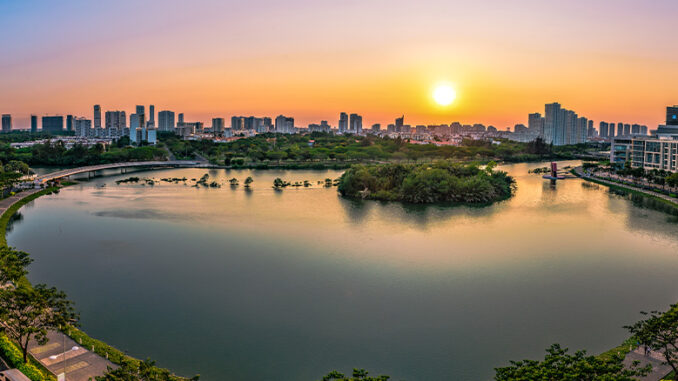
The Vietnamese are becoming market-oriented in real estate and living standards. Phu My Hung and Thao Dien areas, developed on vacant farmland, are popular with foreigners in Ho Chi Minh City. Their developments show how foreigners have changed the Vietnamese urban lifestyle. Social infrastructure, such as multinational schools and Western-style eateries, is the main cause. Foreigners’ appearance improves the locals’ landscape and living conditions.
Introduction
Since Vietnam opened its doors to international investment in 1993, Ho Chi Minh City (HCMC) has become a significant centre for foreigners’ business and social activities, whether corporate or private. Either because of the open economy or the presence of foreigners, or both, notable transformations in the city, especially in infrastructure, real estate, and the local economy, have occurred. The rise in international inhabitants and businesses has led to a surge in real estate development in the suburbs. Upscale apartments, commercial buildings, and retail areas have developed, especially in expatriate-populated areas such as District 7 and District 2 (Harms, 2016). These regions have been modified to meet the requirements of the multinational population, offering facilities that conform to norms that were not widely seen in Vietnam before Doi Moi, and perhaps not at the beginning of Doi Moi in 1987.

New areas such as Phu My Hung (PMH, District 7) and Thao Dien (TD, District 2) were developed to cater to foreign residents in Ho Chi Minh City from 1997 to today (Fig. 1). Using field observation, and mapping the article reviews the development of PMH and TD townships to understand how Vietnam, as represented by HCMC, accommodates foreigners.
Table 1. Comparison between Phu My Hung (PMH) and Thao Dien (TD)
| Characteristics | Phu My Hung area | Thao Dien area |
|---|---|---|
| Developer | Taiwanese | Government |
| Main Foreigner groups | Asian | European |
| Location | District 7 | Thu Duc City |
| Number of Foreigners | 13.000 | 12.000 |
| Number of International School | 9 | 17 |
| Type of housing | Condo and Villa | Condo, Villa and Shophouse |
| Maintainance and security | Private+ Public | Public |
| Area (ha) | 433 | 375 |
| Zoning | Mixed-use development model | Mixed-use development model |
Case Study 1: Phu My Hung (PMH)
Following Vietnam’s reunification in 1975. HCMC planned to develop an area south of the city, Saigon South, encompassing three key projects: Tan Thuan Export Processing Zone (EPZ), PMH area, and Hiep Phuoc Industrial Park, as part of a broader program (World Bank, 2017).
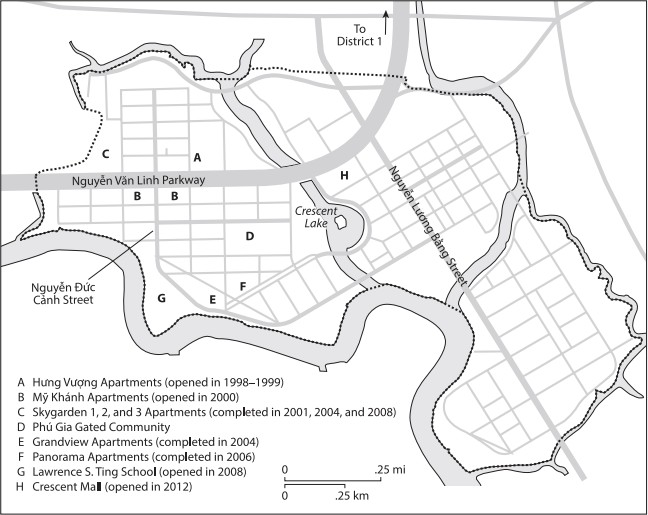
Hưng Vượng (Fig. 3) is an example of a luxury residential development located in the central Phu My Hung area. In 2015, the area comprised nine residential complexes, accommodating 354 homes and 1300 residents (Le & Le, 2018). The neighbourhood included gated community characteristics, with regulated access provided by walls and security gates. The complex featured an outdoor garden, shared parking lots, a playground, and internal roadways in the plan.
The management enforced ordered urban living principles, including no waste on the ground, proper waste disposal, waste collection, and pavement parking. The rules addressed building shapes, Condo layout design models, and town behaviour. PMH provides a legal framework to strictly manage complicated blocks and urban areas.
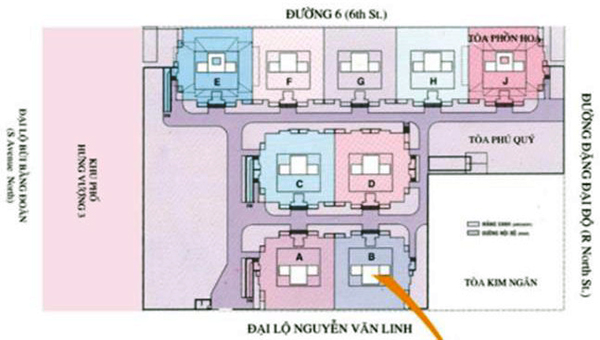
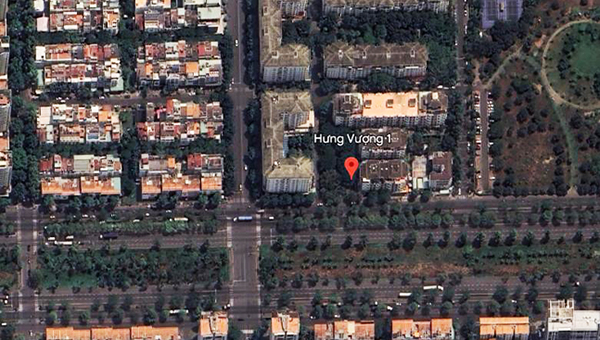
The Korean International School of HCMC (KIS), the Canada International School (CIS), the ABC International School, the Vietnam Australian (VAS), the Vietnam Finland International School (VFIS), and the Saigon South International School (SSIS) are among the main reasons Koreans move there. Allowing for the transfer of credits from Vietnamese overseas institutions to Korea allows students to effortlessly advance their education in Vietnam, following their parents’ posting here. (Huynh, 2015).
Compared to other Korean towns worldwide, Phu My Hung is the best copy of the Korean social system (Kim, 2016). The management board established a security system of approximately 300 private security guards for the neighbourhood. The area is safe for strangers, with no violence or high crime rates (Douglass & Huang, 2007). There are shopping stores, restaurants, and market facilities with the Korean language everywhere. Koreans can live in PMH without knowing Vietnamese and would feel safe like would be at home.
In 2015, PMH had 26,950 residents, 56% of whom were foreigners from South Korea, Japan, Taiwan, Singapore and China; 27% were Korean. More than 60% of PMH residents were non-Vietnamese in 2018. Population rose to 30.000 in 2018, 40.000 in 2020, and 35.000 in 2023. PMH descended from being a favourite long-term home for settlers due to bad traffic leading from the city centre to it. (Huynh, 2015). After COVID-19, PMH has only 31% foreign inhabitants (Quy, 2023). In 2024, there was a trend of Koreans gravitating towards Thu Duc City. Foreigners have started abandoning PMH for Thao Dien (TD) in Thu Duc City. (Lan & Huong, 2024).
Case Study 2: Thao Dien (TD), Thu Duc City
Since 1997, TD (Fig. 4) has undergone considerable urban planning and development, making it appealing to Vietnamese and tourists. Wide sidewalks, tree-lined roads, and pedestrian zones are district authority priorities. Traffic decreases and healthy walking and cycling are promoted. Home, business, and retail are integrated in TD. Because of its lively atmosphere, inhabitants may readily reach shops, restaurants, businesses, and entertainment. The area had less of the organized, structure ways of PMH in terms of arthicture and housing design. Its huge residences reflected affluent European history with several European design styles from different eras. Now a zone for mixed-use, TD now contained restaurants, bars, and retail shops among its shophouses. Various individuals from Europe, America, Africa, Singapore, Korea, and Taiwan reside together in homes featuring multiple architectural designs. The town is close to the new metro line. TD’s design is less modern than PMH. TD has developed naturally, adding new constructions to old ones. At the same time, Phu My Hung was carefully designed and constructed from scratch to adhere to particular urban living criteria, such as green spaces for parks, recreational areas, and community spaces.
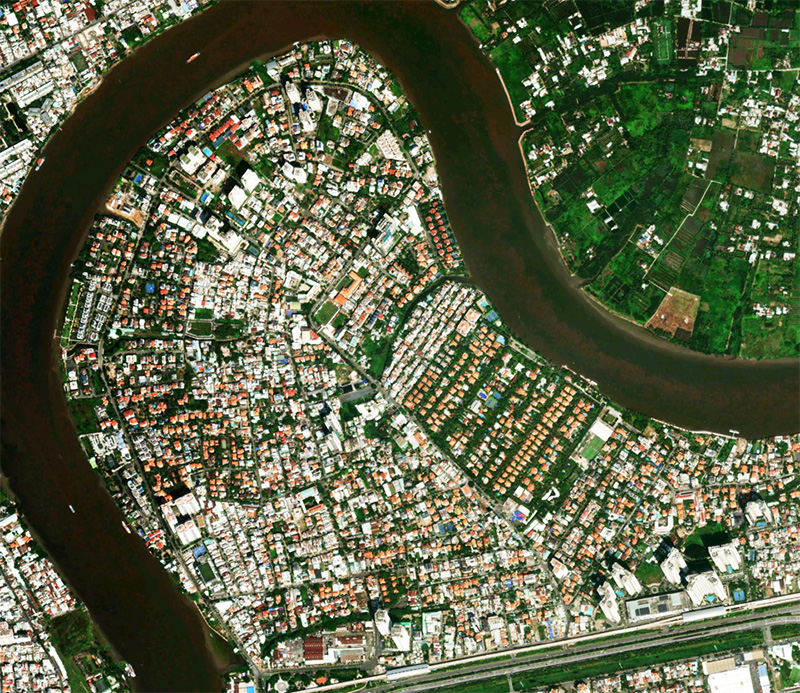
Like PMH, TD has several international English-medium schools from the UK, America, Australia, and Europe. These international schools serve children aged 3 to 18. Foreigners find TD welcoming due to its diverse international community. The schools were the most attractive reason for foreigners to reside in TD.
Looking into types of accommodation choices to accommodate foreigners’ varying lifestyles and financial means, several housing choices in Thao Dien are tailored explicitly for expatriates. They often have Western-style designs, spacious open living areas, contemporary kitchens and bathrooms, and premium finishes in the gated community (Lan & Huong, 2024). Normally, Vietnamese have tiny classic kitchens and cheap bathrooms. Wealthy Vietnamese individuals are now accepting new, elevated standards for their living spaces’ exterior and interior. High-end, high-rise apartments offer beautiful city views, and modern amenities such as fitness centres, pools, and security measures are attractive to city dwellers. In the same area, large villas provide a luxurious and secluded living place with plenty of family room. New townhouses offer a harmonious blend of seclusion and community, making them perfect for individuals looking for a more interconnected environment. The traditional Vietnamese home is narrow and long and has no garden.
Comparing Urban Morphology
TD is known for its diverse range of services and facilities targeted to international inhabitants, including international schools, Western-style restaurants, and English-speaking service providers. This environment can significantly facilitate lifestyle adaptation by English-speaking expatriates who are integrating into life in Vietnam. However, the cost of living is higher than in other areas due to the concentration of expats, with a possible reason being residents’ higher ability to spend in these areas.
On the other hand, PMH is a high-end urban district with excellent large-scale infrastructure. The population structure is a mix of Vietnamese professionals and foreigners. PMH offers a more modern and planned city experience, more spacious with parks and lakes, and a more comprehensive range of housing options (Fig.5) . English spoken at PMH may not be as widely spoken as in TD, but they suffice.

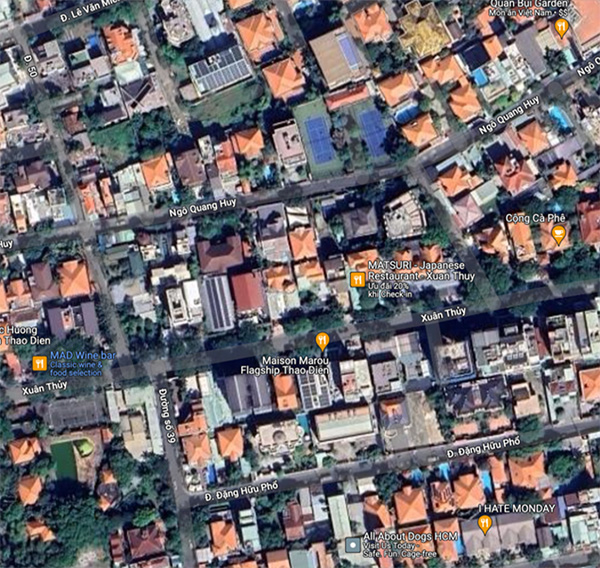
PMH has a grid-like urban design that is typical of planned projects. Modern urban projects and redeveloped neighbourhoods follow this trend. A clear roadway hierarchy and block patterns make navigating the traffic and using land efficiently easier. Whereas this was not always the case in old urban areas of Vietnam, with spider-web like road networks and confusing house numbers. It was not always easy to arrive at a Vietnamese person home in older areas, but in PMH, this was easy.
TD’s layout varies in block and plot shapes and sizes. This implied organic growth without centralized planning or urban planning. These sites may be unique and represent past growth patterns, but their unpredictability might cause infrastructure and public service delivery challenges. In this sense, TD’s future development trajectory might more closely resemble older urban areas.
Both urban planning methods have pros and cons. PMH-type layouts can sustain infrastructure and services but they may not have organic appeal. TD unconventional designs may exhibit local culture and history and offer a distinctly urban experience, but they also face logistical challenges. TD’s path may produce more chaos and disorderliness. Foreigners like Thao Dien’s unusual designs, though.
Conclusion
PMH and TD were towns partly built to accommodate a foreign way of life. They offered various housing options, including villas, townhouses, and high-rise apartments designed with Western space standards and advanced social ỉnfrastructure.
The two cases were new ways to develop a new town in Vietnam. The Taiwanese developer for PMH spent a lot of time and money developing social infrastructure (parks, schools) in advance of selling real estate. TD also copied that way, setting up many international schools. Wealthier buyers are willing to pay to live in higher-class housing and houses because these accommodation offered an environment similar to developed countries, which Vietnamese people have not known before the 1990s.
Ho Chi Minh metropolis is diversified with many living levels. It had become more welcoming to foreigners in terms of new townships that cater to foreign lifestyles that have also won over the hearts of Vietnamese that make a conscious and rational choice to live in PMH and TD. Thus, the impact of Doi Moi, of opening up to foreigners residing in Vietnam, of urban developing is notable and would continue for some time.
Thanh Bao Nguyen1 and Hung Minh Ngo2
1,2 Van Lang University, Vietnam
Corresponding email: thanh.nb@vlu.edu.vn
Banner: Twilight on Ban Nguyet riverbank, cityscape of Phu My Hung, Dist 7, Ho Chi Minh. Photo: Dorothy Pham, Shutterstock
References
Douglass, M., & Huang, L. (2007). Globalizing the city in Southeast Asia: Utopia on the urban edge–the case of Phu My Hung, Saigon. International Journal of Asia-Pacific Studies, 3.
Harms, E. (2016). Luxury and Rubble: Civility and Dispossession in the New Saigon: University of California Press.
Huynh, D. (2015). Phu My Hung New Urban Development in Ho Chi Minh City: Only a partial success of a broader landscape. International Journal of Sustainable Built Environment, 4(1), 125-135. doi:https://doi.org/10.1016/j.ijsbe.2015.03.005
Kim, D.-Y. (2016). A Study on the Characteristics of the Planned New Town Apartments in Vietnam – Focusing on the Ho Chi Minh City the Phu My Hung Area. Korean Institute of Interior Design Journal, 25, 101-111. doi:10.14774/JKIID.2016.25.2.101
Lan, N. T. H., & Huong, L. T. T. (2024). Gated Community vs. Inclusive Urban Development: A Case Study of the Old District 2, Ho Chi Minh City, Vietnam. Paper presented at the Asian Urbanization Conference 2024, The Vietnamese-German University (VGU)-Ho Chi Minh City.
Le, T. T. H., & Le, T. T. H. (2018). Privatization of neighborhood governance in transition economy: a case study of gated community in Phu My Hung new town, Ho Chi Minh City, Vietnam. GeoJournal, 83(4), 783-801. doi:10.1007/s10708-017-9803-x
Quy, H. (2023). Hành Trình Khát Vọng. Tuoi Tre. Retrieved from https://tuoitre.vn/khu-do-thi-phu-my-hung-hanh-trinh-khat-vong-20230517172414994.htm
World Bank. (2017). Phu My Hung, Ho Chi Minh City, Vietnam – Case Study. Retrieved from https://www.thegpsc.org/sites/gpsc/files/3._ho_chi_minh.pdf
